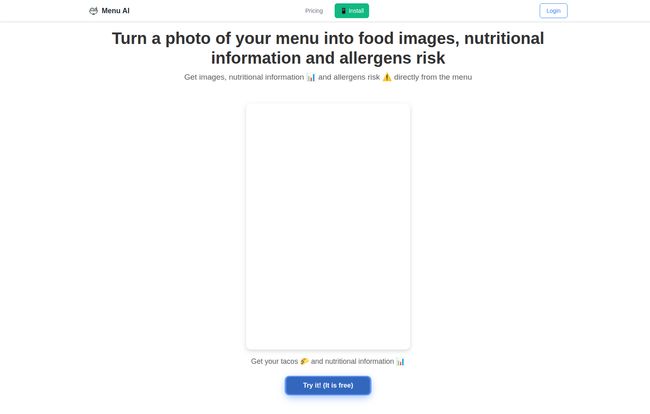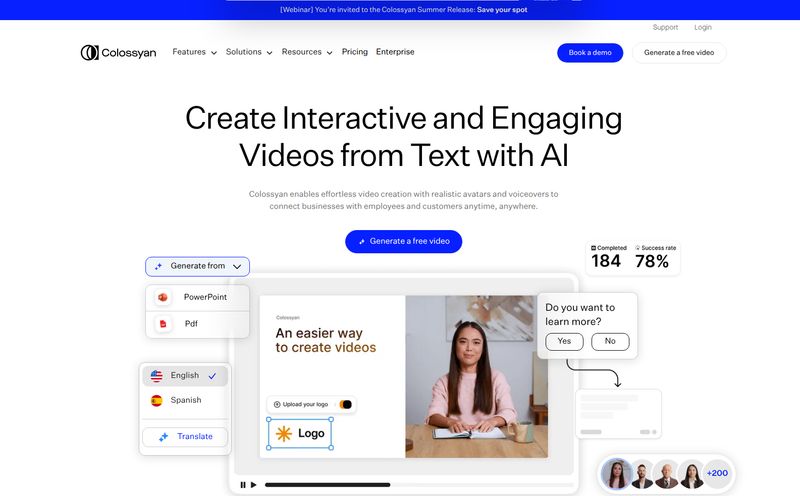We've all been there. Staring at a menu, squinting at fancy descriptions like "Pan-seared branzino with a fennel-citrus slaw and a saffron-infused foam." Sounds delicious, right? But what does it actually... look like? And what on earth is in a saffron-infused foam that my calorie-tracking app needs to know about? The modern dining experience is often a game of delicious guesswork.
For years, I’ve navigated menus with a mix of hope and my phone’s search browser, frantically googling ingredients under the table. It’s not exactly a smooth process. So when I stumbled upon a tool called Menu AI, the premise alone had me hooked. It claims you can just snap a photo of a menu and it will generate images of the food, pull up nutritional information, and even flag potential allergens. A bold claim. It's like having a food psychic in your pocket.
Naturally, my inner tech and food nerd had to take it for a spin. Could this simple-looking web app really solve one of my biggest dining-out pet peeves?
So, What Exactly is Menu AI?
The concept is beautifully simple. Menu AI is a tool designed to demystify restaurant menus. You upload a clear picture of a menu—could be a fancy dinner menu or a crumpled takeout leaflet you found in a drawer—and its artificial intelligence gets to work. It reads the text and then does three main things:
- Generates Food Images: It creates a visual representation of what the dish might look like. No more guessing if the 'Chef's Special' is a soup or a steak.
- Provides Nutritional Data: It estimates calories and offers a detailed nutritional breakdown. A game-changer for anyone tracking their intake.
- Flags Allergens: It scans the ingredients for common allergens, giving you a heads-up before you order.
Its a simple idea, really, but the execution is where the magic is supposed to happen.

Visit Voice Cloner
My First Date with Menu AI
To put it to the test, I grabbed the menu from my favorite local Thai place. The lighting in my apartment isn't exactly studio-quality, but I snapped a decent photo and uploaded it. The site whirred for a moment, processing the image. I was half-expecting a glitch or an error message, as is so often the case with new AI tools.
But then, it populated. Alongside the familiar names like "Pad Thai" and "Green Curry," there were now AI-generated images. The Pad Thai looked surprisingly accurate, down to the crushed peanuts and lime wedge. The Green Curry... well, it looked a bit more like a generic green soup, but it was a valiant effort! The point wasn't photorealism, it was about getting the idea of the dish. And it worked.
The nutritional info was the next surprise. It gave me a calorie estimate for each dish that seemed, well, plausible. For anyone who's ever tried to log a restaurant meal into MyFitnessPal, you know the struggle. This felt like a massive shortcut.
The Features That Really Cook
From Text to Table: The Image Generation
Let's not downplay this. For visual eaters like me, seeing the food is half the battle. This feature is fantastic for exploring unfamiliar cuisines or menus that are light on descriptions. While the images aren't actual photos from the restaurant, they provide a much-needed reference point that's a huge step up from blind faith.
The Nutritionist in Your Pocket
This is where Menu AI goes from a fun gadget to a genuinely useful tool. Getting an instant breakdown of calories, ingredients, and even dietary restriction filters (like vegan or gluten-free) is incredible. It empowers you to make informed choices that align with your health goals, without sucking the joy out of eating out. It's about awareness, not restriction.
Navigating the Allergy Minefield
For friends and family with food allergies, dining out can be stressful. The allergen risk feature is perhaps the most important thing Menu AI offers. Being able to get an initial AI-powered flag for things like nuts, dairy, or gluten before even speaking to a server adds a layer of safety and peace of mind. Of course, you should always double-check with the restaurant staff, but as a first line of defense, it’s brilliant.
Let's Talk Price: Is Menu AI Worth the Dough?
The tool has a pretty straightforward pricing structure, which I appreciate. No hidden fees or confusing credit systems. It’s broken down into a few tiers.
| Plan | Price | Best For |
|---|---|---|
| Free | $0 | The curious user who wants to try it out once or twice. |
| Pro | $4.99 / month | Health-conscious individuals or serious foodies who eat out regularly. 100 scans is plenty for most people. |
| Premium | $9.99 / month | Power users who want unlimited scans and the fastest, most accurate AI models available. |
| Enterprise | Custom | Restaurants looking to enhance their own digital menus with QR codes, images, and automated nutritional/allergen info. |
Honestly, for most people, the Pro plan at $4.99 is the sweet spot. But the Enterprise plan… that’s where my SEO brain starts buzzing. Imagine a restaurant integrating this tech into their QR code menu. Customers could instantly see images and nutritional info, which studies show can increase the average ticket value. It's a smart play for any modern restaurant.
The Real-World Verdict
So, is Menu AI perfect? No, of course not. The AI's image generation can be a bit hit-or-miss, and the accuracy of the nutrtional data is ultimately an educated guess. The quality of your menu photo is also a huge factor. A blurry, dimly lit photo will yield subpar results.
But here’s the thing: it doesn't need to be perfect. It needs to be better than the alternative, which is guessing. And it absolutely is. It turns an opaque document into an interactive, informative guide. It gives you more data to make a better decision, and in the world of food and health, that's a massive win.
"It’s less about replacing the conversation with your server and more about starting that conversation from a place of knowledge."
I think that’s the key. It's a tool to augment the dining experience, not fully automate it. It's a bridge between the chef's creation and the customer's understanding.
Frequently Asked Questions
- How does the menu processing work?
- Menu AI uses Optical Character Recognition (OCR) to read the text from your uploaded menu photo. Then, its artificial intelligence models analyze the dish names and descriptions to generate images, estimate nutritional values, and identify potential allergens.
- Is there a free trial for Menu AI?
- Yes, the website has a free-to-try option right on the homepage, allowing you to test out the core functionality before committing to a paid plan.
- How do I cancel my subscription?
- Based on their FAQ, you can manage and cancel your subscription through your account settings. It seems to be a straightforward process.
- What photo formats can I use?
- While the site mentions image support, it's safe to assume standard formats like JPEG, PNG, and HEIC from your phone will work just fine. For best results, use a clear, well-lit photo.
- How accurate is the nutritional and allergen information?
- It's an AI-powered estimation. It should be treated as a very helpful guide, not as certified medical advice. Always confirm with the restaurant staff if you have a serious allergy.
- Can I use Menu AI for any restaurant in the world?
- Pretty much! As long as the menu is in a language the AI can process and the photo is clear, it should work on menus from a tiny local cafe to a fancy international restaurant.
The Future of Dining or Just a Fun Toy?
After playing around with Menu AI for a while, I'm genuinely impressed. It’s one of those tools that, once you use it, you wonder why it didn't exist sooner. It solves a real, everyday problem with a clever and accessible solution.
While some might see it as a toy, I see it as a powerful tool for empowerment. It empowers health-conscious diners, protects those with allergies, and satisfies the curiosity of adventurous eaters. And for the restaurant industry, the potential of the Enterprise features could be transformative. It’s not flawless, but it's a fascinating and incredibly useful glimpse into a future where we walk into every restaurant knowing exactly what we’re getting ourselves into. And I'm here for it.



